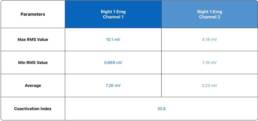The metrics
Electromyography (EMG) is a valuable technique for studying the electrical activity of muscles during various actions and movements. To analyze these EMG signals, several parameters are used, including Peak RMS (Root Mean Square), Average RMS (Root Mean Square) and Co-activation Index.
Each of these parameters offers a unique insight into muscle activity and coordination between muscles during specific tasks. In this guide, we explore in detail these EMG measures and their use in the assessment of muscle activity and coordination.
1) Peak RMS (Root Mean Square)
– Peak RMS, also known as “maximum RMS value,” represents the maximum amplitude of the EMG signal over a specific period, which can be useful for identifying peaks in muscle activity during intense muscle contractions.
2) RMS (Root Mean Square) average
– Average RMS, also known as “mean RMS value”, is a measure of the average amplitude of EMG signals recorded over a given period.
– Average RMS is often used to assess overall muscle activity during a given task or period, providing an indication of the average intensity of muscle activity.
3) Co-activation index
– ⚠️ The coactivation index only appears when the 2nd channel has been selected and placed on an antagonist.
– The coactivation index is a measure of the relative coordination between two antagonistic muscles (muscles with opposing actions) recorded using EMG.
– It is calculated by comparing the electrical activity of agonist muscles (which perform an action) and antagonist muscles (which oppose the action) during a given task or movement.
– A high coactivation index may indicate poor muscle coordination or overuse of antagonist muscles.

